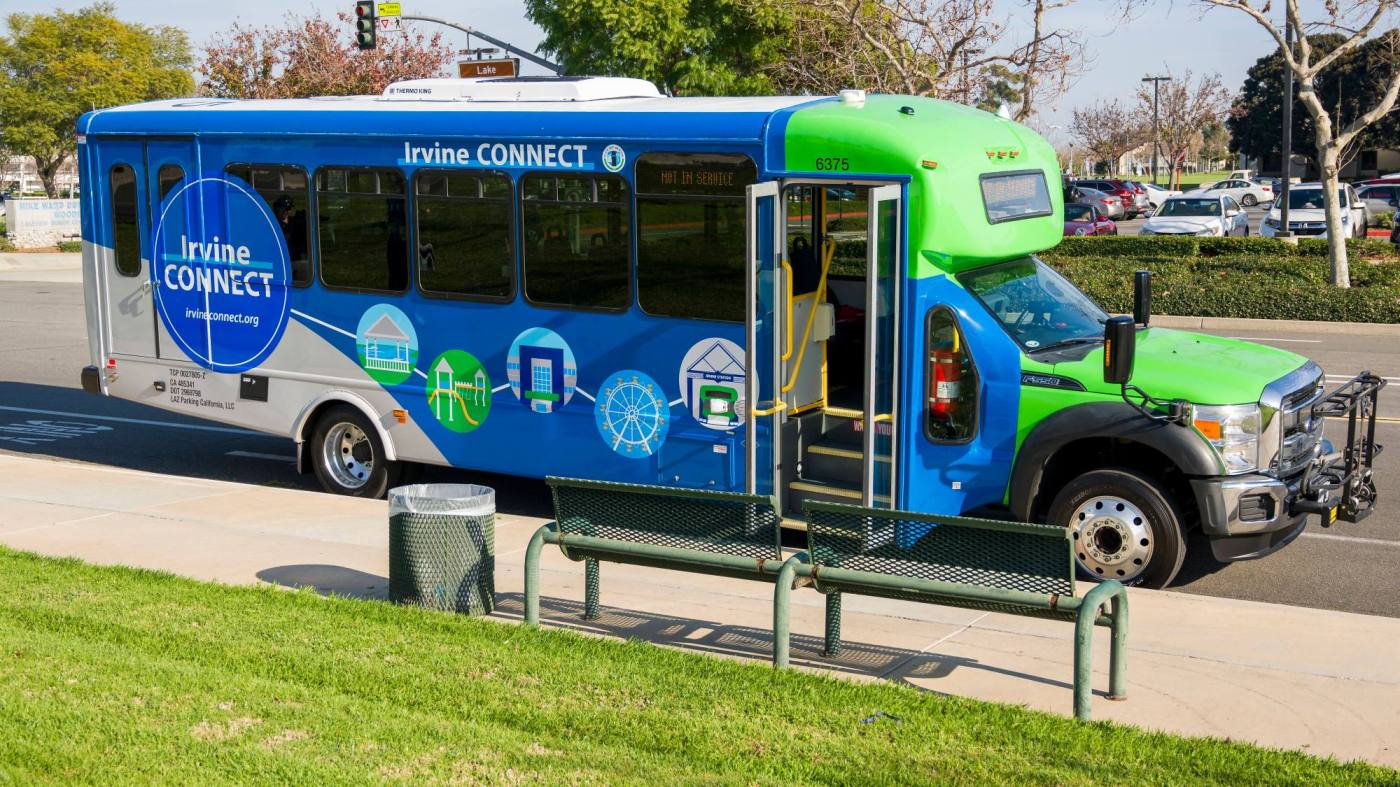The city of Irvine this week unveiled a free shuttle service city leaders say will provide residents with convenient access between homes, schools and workplaces.
Called Irvine CONNECT, the new service will be fully ready for community members to use beginning April 1. On weekdays, the shuttle will run from 6 a.m. to 8 p.m., and on weekends from 8 a.m. to 10 p.m.
“This is the first city shuttle that focuses on residents and connects them from residences along Yale and Barranca to schools, parks, community centers, hospitals, Irvine Spectrum and Irvine train station,” said Mike Davis, the city’s transportation administrator.
The shuttle route will have roughly 70 stops, between Irvine Station and the northern end of the city, connecting residential areas to community centers, schools and retail centers.
Riders will get access to major destinations including Irvine Spectrum Center, Kaiser and Hoag Hospitals, Heritage Park, Woodbridge High School, Sierra Vista Middle School and Northwood Town Center.
Irvine CONNECT will operate on a 20-minute frequency, although arrival times could “fluctuate based on traffic, weather or ridership volume,” according to the city website.
Route of Irvine CONNECT shuttle service. (Courtesy of Irvine)
Planned as a pilot, one-year program, the hope is to turn it into a permanent city feature, depending on ridership in the first year, Davis said.
Since 2008, the city has been offering to residents iShuttle, operated and managed by the Orange County Transportation Authority, as a link between the Tustin and Irvine train stations and Irvine employment centers. That shuttle is free for riders with a valid Metrolink ticket or OCTA pass, but $1 for those without during peak commute times.
The new shuttle service does not impact existing transit routes, Davis said.
“When we did the study for this, we looked for places that did not have transit service,” Davis said. “This is a new service serving new areas of the city.”
Irvine CONNECT differs from the iShuttle, Davis said, in that while the iShuttle is a commuter bus that mainly serves employees coming into the city to work, Irvine CONNECT is meant to serve residents within the city.
The service is also part of the city’s push to go green, he said. The buses use compressed natural gas, a “gasoline and diesel fuel alternative consisting primarily of methane,” according to the California Air Resources Board.
“Compressed natural gas is pretty darn clean — not as clean as electric or hydrogen, but down the road we’d love to go to that,” Davis said.
Five of the seven blue and green buses on the route (two are owned by route operator LAZ Transportation Services) are repurposed iShuttle buses, Davis said. Four buses will run regularly and a fifth will be added during peak commuter hours to meet the 20-minute frequency; two will be on standby in case a bus goes down.
The total cost to operate and implement the shuttle service in the first year is approximated at $4.1 million, Davis said. Outreach and operational costs, which include wifi and fuel, will be around $2.6 million.
The upfront, one-time cost, which includes wrapping the buses, adding 37 new stops in the route — most of them along Yale Avenue — bus stop improvements and ADA accessibility upgrades will be at around $1.5 million, he said.
The building of the new stops, which comes with a roughly $1.2 million price tag, will be funded by the city’s Capital Improvement Projects budget. Irvine Recovery Plan funding will foot around $476,000, and $2.4 million will come from Prop. 116 funds and Measure M funds, a half-cent sales tax that funds transportation projects in the county.
“OCTA understands that public transit is not one size fits all,” said spokesperson Eric Carpenter. “In addition to the OC Bus system, we provide funds through the Measure M half-cent sales tax, for smaller community shuttles that meet more localized mobility needs.”
“Those shuttles might be to help people get to the beach during the busy summer months, or to employment centers, or important shopping and entertainment destinations,” he said. “We want to encourage people to use public transit to help take more cars off local roads, ease traffic congestion and provide cleaner air in the process.”
Related Articles
Legislators move to give more power to the state in managing local rail service
Buses and trains see some delays, but public transit works well in storm
LA, OC, and Inland public transportation services celebrate Transit Equity Day with free rides — and a history lesson
Transit Equity Day means free rides on Metro, Metrolink, OC, Riverside and San Bernardino transit
People movers to LAX, Inglewood’s SoFi Stadium face new delays
The service was supposed to begin in January, but was slowed down due to a delay in the design process of the new bus stops, Davis said.
“As we started designing those 37 new stops, we found issues that we weren’t aware of originally, like we had to move some stops because they were near water meters, we also had to expand some sidewalk,” he said. “There were also things underground we discovered and had to redesign some of the stops.”
It will take 4-6 weeks to build most of the stops, Davis said, and the majority of them will be up by April 1. If a rider needs to get off at a stop that isn’t completed by the time service begins, the driver will stop as near to it as possible, he said.
Riders will be able to access free wifi service on the bus. Service animals are allowed as well as small pets as long as they are in a pet carrier, according to the website.
Service won’t be available on several holidays: New Year’s Day, Memorial Day, Thanksgiving Day, Independence Day, Labor Day and Christmas Day.





